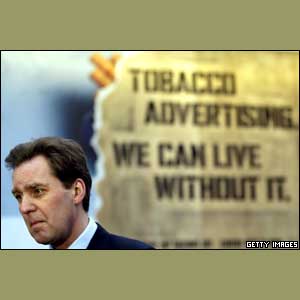 January 18, 2011 - Tobacco advertisements really do prompt teenagers to smoke, say the authors of a new study that calls for a ban on cigarette ads.
January 18, 2011 - Tobacco advertisements really do prompt teenagers to smoke, say the authors of a new study that calls for a ban on cigarette ads.
PAPER: Cigarette Advertising and Teen Smoking Initiation, Reiner Hanewinkel, PhD, Barbara Isensee, PhD, James D. Sargent, MD, Matthis Morgenstern, PhD, Pediatrics, Published online January 17, 2011, ABSTRACT..
In research involving more than 2,100 public school students in Germany, 277 young people who had never smoked before took up the habit after viewing tobacco advertising. Those who saw the most ads were 46 percent more likely to try cigarettes than those who saw no tobacco ads, the study found.
Students involved in the study ranged from 10 to 17 years old, with an average age of 12.5 years, when the study began. They were shown 12 ads with branding removed -- six for cigarettes and six for other products, including candy, cars and cell phones. They were asked to identify the product advertised and recall the brand if they could.
After nine months, 13 percent of the students who had seen tobacco ads began smoking, showing a strong connection between the behavior and tobacco advertising, said Sargent. And the more ads they saw, the more likely they were to start smoking, the study found.
Cheryl Healton, president and CEO of the American Legacy Foundation, an anti-smoking organization: this [study] is very important because there are few, if any, longitudinal studies," demonstrating a link between tobacco advertising and teen smoking. Previous research has mostly relied on cross-sectional studies, she said. That type of study documents incidence of a behavior at a certain point in time and may suggest a link between, say, smoking and advertising, but it doesn't show cause-and-effect. A longitudinal study, on the other hand, follows participants for a period of time in an effort to demonstrate that one causes the other.
Advertising exploits themes that are meaningful to teens including sex appeal, masculinity for boys, thinness for girls, and social acceptance, according to research cited in the study. Most smoking starts during adolescence, and because tobacco is a powerful psychoactive drug, the path to addiction readily follows, the authors added.
Healton said tobacco companies spend about $30 million a day on advertising in the United States alone. They "have to get young people to smoke or else they will go out of business," she said. Although tobacco advertising is banned on American television, Healton said some TV programs promote smoking by showing characters lighting up.
References: Cigarette Ads Do Spur Teens to Light Up, Study Finds The more advertisements they saw, the more likely they were to smoke, researchers say by Ellin Holohan - HealthDay Reporter, Bloomberg Business Week, 1/17/2010.
A few related news briefs:
PAPER: Pro-tobacco videos have a significant presence on YouTube..;
Young adolescents exposure to tobacco ads and cigarette smoking..;
Study finds teens twice as likely to try smoking if they frequent stores plastered with cigarette ads..;
Youth exposed to smokeless tobacco ads despite settlement…;
Tobacco industry has long targeted young people as "replacement smokers";
New Zealand - study revives interest in keeping tobacco hidden...
(kids, children)
Bringing the World of Tobacco Control closer together..
PAPER: tobacco advertisements prompt teenageers to smoke..
Subscribe to:
Post Comments (Atom)


To Provide Public Awareness
Purpose
About Us
Contact Us
2008 HIGHLIGHTS
TOPIX PAPERS - 2008 & 2009..
Archive
-
▼
2011 (490)
-
▼
01/16 - 01/23 (30)
- Canada - the National Coalition Against Contraband...
- Smoking in a car, even if window is open, exposes ...
- Jersey - UK - vote in favor of graphic warnings on...
- Maine - anti-smoking groups want an increase in st...
- Bulgaria - Bulgartabac - sale should be completed...
- Maharashtra, India - collecting fines from anti-...
- Jakarta, Indonesia - lawyers mount bid to challeng...
- Estonia - with unemployment high people turn to bl...
- Kyoto, Kyoto Prefecture Japan - looking into bann...
- RAI - February 3, 2011 - 4th quarter and full year...
- American Lung Association - Annual Report: Tobacc...
- California - La Palma's Central Park will be toba...
- Ireland - must substantially increase fines and pr...
- France - MPs to vote to allow-their-bygone-heroes-...
- Canadian Cancer Society - wants Alberta and all ot...
- Greece - govt takes stand - this smoking ban is go...
- PAPER: Do smoke-free laws affect revenues in pubs ...
- Raleigh, N.C. - city council to develop no smoking...
- India - health ministry formulating policy that is...
- Philippines - former health ministers petition Sup...
- Marlboro snus now comes in a round tin, 2 flavors,...
- Japan - study shows the promotion of menthol cigar...
- PAPER: cigarette smoke causes genetic damage with...
- PAPER: tobacco advertisements prompt teenageers t...
- Canada - National Non-Smoking Week, January 16-22,...
- Where's the FDA - Walmart may start selling e-c...
- Portugal - government considering expanding smokin...
- Mobile, Alabama - awarded $2.25 million grant for...
- Dragonite International - e-cigarettes. lawsuits a...
- Australia - Philip Morris (PMI) searching for way...
-
▼
01/16 - 01/23 (30)
© Copyright Notice: The content of this website is for information education purposes only and any newsbrief may be used only as "fair use" for information/education purposes with permission of the authors and providing that original references and associated reference links are included in HTML format.
0 comments:
Post a Comment